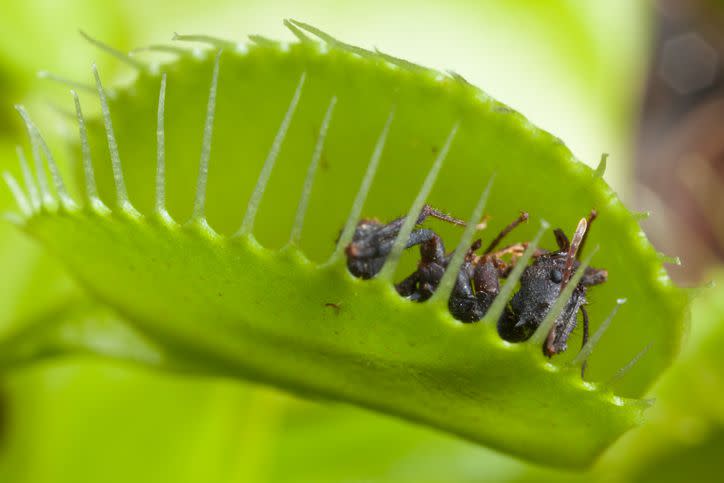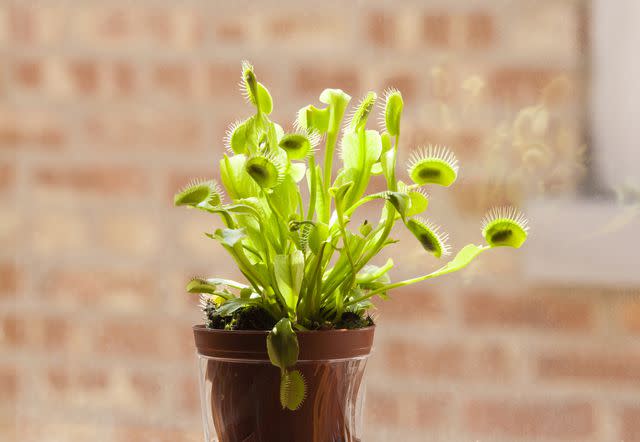The Weird Way Venus Flytraps Eat: What to Know About How to Feed One

TascioPhilip / Getty Images
The world of plants is full of natural wonders, and one of these is the carnivorous Venus flytrap. This plant is unusual looking and has uniquely observable trait—it captures and consumes insects.
How a Venus flytrap eats is unlike how humans eat, with the digestive process happening in a single space called a trap (that's the part people tend to think of as a mouth). As otherworldly it seems, it’s actually a North American native plant found in the coastal plains of North and South Carolina.
Venus flytraps (Dionaea muscipula) are perennial plants that grow best outdoors and can survive 20 years or longer in the wild. They are mostly cultivated and sold as specialty houseplants. If you’ve got one at home, you need to know how and what it eats to you’re prepared to take care of it properly.
What Venus Flytraps Eat
You do not have to feed a Venus flytrap insects for it to survive. Just like all other plants, the Venus flytrap makes its own food through photosynthesis by using energy from captured sunlight to pull nutrients from the soil.
However, what's different about the Venus flytrap is that it thrives in poor soil and benefits from the supplemental nutrients it gets from consuming live insect prey. Think of insects as the fertilizer you might use to feed other plants.
The insects are made of digestible materials high in essential plant nutrients like nitrogen and phosphorous that often are not sufficient in the plant's boggy, acidic habitat. Some examples of insects the Venus flytrap eats include:
Ants
Beetles
Grasshoppers
Flying insects
Spiders

Deanna Kelly / Getty Images
How Venus Flytraps Eat
The Venus flytrap catches its prey with two hinged lobes on the end of each leaf. The insides of the lobes have small hair-like projections called trichomes which, when stimulated by moving prey, cause the two lobes of the plant to snap together. The lobe edges are bristled with spiky extensions that interlock when the trap shuts to prevent the prey from escaping. At this point the trap has just begun the feeding action. There are, however, some small spaces between the bristles that the smallest prey can attempt to escape through.
The trichomes must continue to be stimulated for the bristles to close and interlock completely making the trap airtight. This means the Venus flytrap must be fed live prey. Otherwise the lobes fail to lock completely and digestion of the food source stops. In this case, the trap reopens in a day or two, releasing the undigested material.
When the trap does completely close around live prey, digestive glands on the interior edges of the lobes release enzymes that break down and liquefy the soft parts of the prey. Nutrients are extracted and absorbed into the plant.
Depending on the type and size of insect, the trap remains closed for five to 12 days before reopening to release the exoskeleton.
Each trap on the plant is able to open and close a limited number of times. Traps consume between three and five meals before they no longer capture prey and simply remain on the plant as photosynthesizing organs before dropping off the plant.
Warning
Don't touch your Venus flytrap's traps just for fun. Offering your plant an inappropriate food source or even brushing the inside trichomes with your fingers or other objects will cause it to close only partially and can quickly use up that individual trap's ability to close. About ten unsuccessful trap closures result in the Venus flytrap failing to respond to contact.
What to Feed a Venus Flytrap
The general consensus is that Venus flytraps should be fed live insects; they will provide the greatest benefit to the plant.
The type of insect to feed a Venus flytrap depends on the size of its traps. Large traps can handle larger insects like grasshoppers and centipedes, whereas small traps need smaller prey like gnats, ants and flies.
Venus flytraps grown outdoors year round do not need to be fed at all and will capture and consume on their own what they need to support healthy growth.
Even Venus flytraps kept as houseplants can often capture and digest small indoor insects to support continued growth. Alternatively, you can use a tweezer to hold the live insect and move it across the trap's trichomes to stimulate the trap to close. Once this happens remove the tweezer and the movement of the insect inside the trap will initiate the airtight seal to start the digestive process.
When to Feed a Venus Flytrap
When to feed also depends on the number of traps on the plant; the more traps on the plant, the more often it will need to feed. Some growers recommend at least one of the plant's traps should be digesting food at all times when actively growing.
Venus flytraps grow slowly so you may want to try to skip winter dormancy the first year with a small plant by bringing it indoors (if it was outside) and feeding it every two weeks or so.
Frequently Asked Questions
Can you feed a Venus flytrap dead bugs?
No, you cannot feed a Venus flytrap dead bugs. Dead bugs will likely be rejected because they fail to stimulate the small hairs inside the lobes that lock the trap and release digestive enzymes. The trap may not close completely or will simply reopen in a day or two with the dead prey intact.
Will a Venus flytrap survive without eating bugs?
This carnivorous plant can survive several months without the necessary nutrients provided by digesting prey. However, deprived of all prey, the Venus Fly Trap will eventually die back.
Can Venus flytraps eat fruit instead of bugs?
Sugars contained in fruit will likely cause your Venus flytrap to rot. The trap is also more likely to fail to close completely and simply reopen in a day or two rejecting the fruit.
13 Pretty Carnivorous Plants That Eat Bugs
Read the original article on The Spruce.

